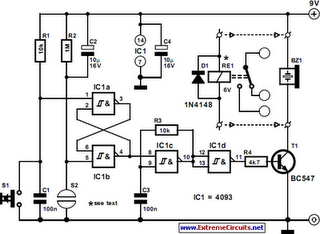Home » Circuits
Simple Moisture Detector
The function of this circuit is to sound a buzzer, or, optionally, actuate a relay, when a certain moisture level is detected between a pair of probes. The circuit has a ‘memory’ in the form of a flip-flop, IC1a-IC1b, which enables or disables a tone oscillator, IC1c. The flip-flop is reset either by C1 and C2 when the supply voltage appears, or by push-button S1. This may not reset the alarm, however, which will sound again until the probes are ‘dry’. The (passive) buzzer may be replaced by a relay actuating an externally connected sounder, lamp or other high-power signalling device. Because the duty factor of the coil voltage is about 0.5, the relay should be a type with a coil voltage which is lower than the supply voltage.Circuit diagram:

A 6-volt type is suggested if the circuit is powered from a 9-volt supply. The circuit has a modest standby current consumption of between 4 and 5 mA. This rises to about 40 mA when the relay is actuated. The supply voltage is uncritical and may be anything between 3 V and 15 V. Note, however, that it may not be possible to use a relay if a supply voltage lower than about 8 V is employed. If the circuit is found to be too sensitive, the value of resistor R2 may be decreased.
